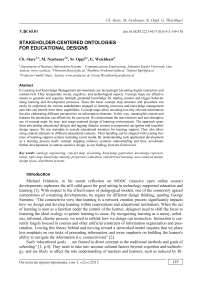Stakeholder-centered ontologies for educational designs
Автор: Stary Ch., Neubauer M., Oppl St., Weichhart G.
Журнал: Онтология проектирования @ontology-of-designing
Рубрика: От редакции
Статья в выпуске: 2 (16) т.5, 2015 года.
Бесплатный доступ
E-Learning and Knowledge Management environments are increasingly becoming highly interactive and content-rich. They encapsulate social, cognitive, and technological aspects. Concept maps are effective means to generate and organize multiple grounded knowledge for sharing content and trigger behavior along learning and development processes. Since the basic concept map structure and procedure can easily be explained, the various stakeholders engaged in learning processes and knowledge management activities can benefit from these capabilities. Concept maps allow encoding not only relevant information but also elaborating different perspectives on information elements. In this way, meaningful content and features for interaction can effectively be conveyed. We demonstrate the non-intrusive and non-disruptive use of concept maps for user- and usage-centered design of learning environments. The approach spans from articulating educational designs and tagging didactic content to purposeful navigation and traceable design spaces. We use metadata to encode educational intention for learning support. They also allow using content elements in different educational contexts. Their handling can be aligned with existing features of learning support systems including social media. By understanding such application development as a learning process itself, concept mapping enforces systemic understanding and thus, accelerates further developments in context-sensitive design, as our findings from the field reveal.
Ontology engineering, e-learning, knowledge generation, knowledge representation, knowledge sharing, progressive education, design space, distributed systems
Короткий адрес: https://sciup.org/170178693
IDR: 170178693
Список литературы Stakeholder-centered ontologies for educational designs
- Feldstein, M. Ubiquity Symposium: MOOCs and Technology to Advance Learning and Learning Research. The MOOC and the Genre Moment, in: Ubiquity, 2014(9), 1-9, ACM, , download from http://ubiquity.acm.org, 16.9.2014. DOI: 10.1145/2591681
- Siemens, G. Connectivism: Learning as Network-Creation, 2005 -http://www.elearnspace.org/Articles/networks.htm/, download 16.9.2014.
- Garrison, D.R. E-learning in the 21st century: A framework for research and practice, 2nd ed., Routledge, 2011, New York.
- Dabbagh, N., Kitsantas, A. Personal Learning Environments, Social Media, and Self-regulated Learning: A natural Formula for Connecting Formal and Informal Learning, in: The Internet and Higher Education, 2012, 15(1), 3-8.
- Gilbert, T. F. Mathetics: II. The design of teaching exercises. Journal of Mathetics, 1962, 1(2), 7-56.


